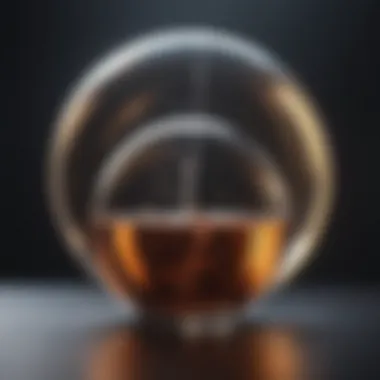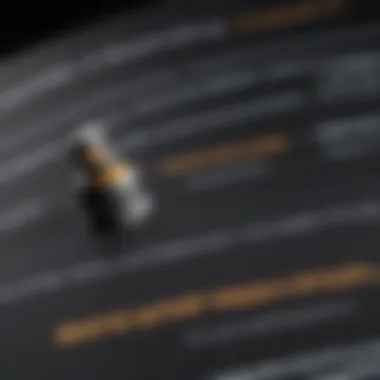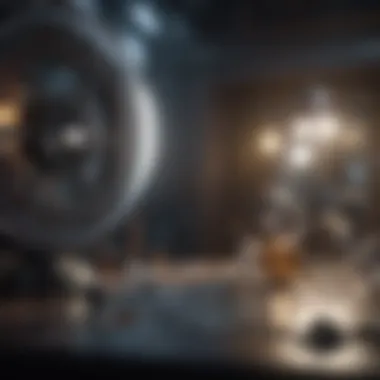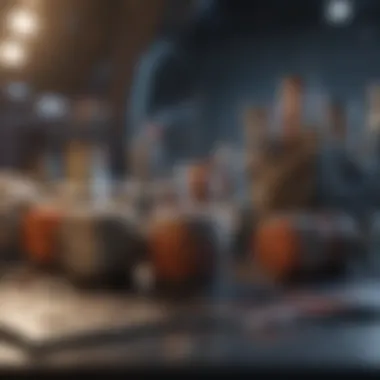Crafting a Winning Scientific Grant Proposal Guide


Intro
In the competitive arena of scientific research, securing funding can feel like an uphill battle. A well-crafted grant proposal isn't just a necessary document; it's a comprehensive articulation of ideas and potential impact that meets the scrutiny of funding bodies. As the landscape of scientific research evolves, so too does the approach needed for effective proposal writing. The stakes are high, and one misplaced comma or unconvincing statistic could mean the difference between receiving vital funds or ending up in the rejection pile.
Getting to grips with the nuances of funding applications is not merely beneficial; it is essential for scientists at all levels. With a plethora of research avenues to explore and a myriad of funding institutions each with their own priorities, understanding how to align research goals with the mission of funding agencies can be the key to success. This guide will provide insight into the art and science of grant writing, reflecting on common pitfalls and shining a light on proven strategies for effectively communicating your scientific vision.
Moreover, the interplay of collaboration and budgeting in your proposal cannot be overlooked. These components not only lend clarity and professionalism but also underscore the broader implications of your research. Through this article, readers will gain a deeper knowledge of what it takes to create a compelling scientific grant proposal, setting the stage for future funding opportunities.
There’s a lot to cover, and we will touch on each aspect meticulously, ensuring that the complexities of the grant-writing process are demystified.
Certainly, it’s a challenging endeavor, but with the right guidance and understanding, the process can transform into a more manageable task.
Prolusion to Scientific Grant Proposals
Crafting a grant proposal is like preparing a well-curated recipe; you need the right ingredients, a pinch of creativity, and a technique that brings it all together. In the realm of scientific research, grants determine whether ambitious projects come to fruition or remain mere speculation. An understanding of grant proposals goes beyond just securing funding; it is a strategic endeavor that can shape the direction of a researcher’s career and contribute profoundly to advancements in various fields.
Definition and Purpose
At its core, a scientific grant proposal is a dynamic document that outlines a research idea, plans the execution of the project, and seeks financial support to make it happen. Divided into distinct sections, the proposal presents the research goals, methodology, significance, and budget in a coherent manner. Its primary purpose is to convince funding agencies that the proposed research is not only feasible but also valuable.
For instance, consider a researcher aiming to study the effects of climate change on local species diversity. The proposal will need to articulate the societal relevance of this research, lay out a method to collect and analyze data, and justify the requested funds. In this context, the proposal serves as both a plan and a pitch, harmonizing scientific inquiry with funding potential.
Importance in Research Funding
Grant proposals are crucial in securing the financial backing that sustains scientific inquiries. Simply put, no cash flow means no progress. The competition for funding is fierce, and many researchers find themselves in a marathon against time and expectations. A well-crafted grant can separate a winning idea from its less fortunate counterparts.
- Financial Lifeline: They serve as a lifeline for researchers, especially in academic settings where budgets are tight.
- Facilitation of Collaboration: Crafting a grant can foster collaborations between researchers, institutions, and industries, bringing together a wealth of knowledge and resources.
- Advancement of Knowledge: Securing funds often translates to groundbreaking discoveries that push the boundaries of current understanding.
Successful grant proposals serve as blueprints for much larger projects and inspire confidence to support innovative research initiatives.
In summation, grasping the intricacies of scientific grant proposals is not merely beneficial; it’s vital for anyone looking to make a mark in research. The proposals act as a bridge between scientific vision and practical realization, enabling ideas to take root and flourish in the world of science.
Understanding Funding Agencies
In the landscape of scientific research, the role of funding agencies cannot be overstated. They are the backbone of financial support that enables researchers to pursue innovative ideas and impactful studies. Understanding the nuances of funding agencies is crucial because it directly influences the success of grant proposals. Funding bodies not only provide monetary support but also shape research agendas and priorities. By grasping their motivations and requirements, researchers can tailor their proposals to align with specific interests, thereby increasing their chances of receiving funding.
Types of Funding Sources
Government Grants
Government grants often represent the gold standard in research funding. These grants are typically vast and come from various levels of government—federal, state, and local. One of the most notable characteristics of government grants is their rigorous selection process. This process aims to ensure that only the most promising and relevant research gets funded. Such grants are particularly beneficial as they not only supply large sums of money but also legitimize the research within the academic and public domains.
A unique feature of government grants is their emphasis on peer review and public accountability. Researchers must detail how their work will benefit society or contribute to scientific knowledge, which can add a layer of pressure but also leads to more meaningful outcomes. On the downside, the application process can be lengthy and complex, often requiring a significant investment of time and resources just to apply. Therefore, while government grants can provide substantial financial backing, the demands can be equally rigorous.
Private Foundations
Private foundations serve a diverse array of fields and interests, making them an attractive option for many researchers. These organizations often have more flexibility than government bodies regarding the types of projects they fund. A key characteristic of private foundations is that they can be responsive to emerging trends or societal needs, enabling them to support innovative and less conventional research.
Their unique feature lies in their ability to provide timely funding, especially in areas where government support has waned. However, one must consider that competition for these funds can be fierce, and thus proposals may face different eligibility criteria that are not as established as government grants. In some cases, foundations may also prefer projects with a strong alignment to their specific mission, which could steer research away from certain exploratory paths.
Corporate Sponsorships


Corporate sponsorships signify another layer of potential funding, especially for research with applicable commercial value. These partnerships can provide substantial resources and access to advanced technology or facilities. A defining characteristic of corporate sponsorship is the expectation of tangible returns on investment, which means researchers often have to ensure that their projects align with corporate goals.
A noteworthy aspect of corporate sponsorships is the potential for collaboration with industry, leading to mutual benefits not only for the researchers but also for the corporate entities involved. However, that comes with drawbacks. Researchers might face limits on publishing their findings or may need to navigate complex intellectual property agreements, which could stifle the openness typically associated with academic research.
Research Priorities of Agencies
Understanding the priorities of funding agencies is paramount; agencies often have specific areas of focus that dictate what types of research they will fund. Keeping abreast of these priorities can help researchers align their proposals with the agency's goals, thereby maximizing their chances of success. Monitoring changes in funding trends and the emergence of new areas of interest among agencies can be especially advantageous for researchers looking to craft compelling proposals.
Core Components of a Grant Proposal
When it comes to crafting an effective grant proposal, understanding the core components is akin to having a roadmap. Without it, you may wander aimlessly, not knowing what’s needed to secure funding. Each element, from the title page to the biographical sketch, plays a significant role in presenting your research clearly and persuasively. Well-defined components not only help convey your ideas effectively but also allow reviewers to grasp your project’s significance and feasibility at a glance.
Title Page and Abstract
The title page and abstract serve as the proposal's initial touchpoints. The title should be catchy yet informative, evoking the essence of your research. Think of it as the first handshake—firm, confident, yet simple. The abstract must encapsulate your proposal in a digestible format, ideally between 150 to 250 words. It highlights the problem, your objectives, and the expected outcomes, all while addressing why these outcomes matter.
"A clear and engaging abstract can be the difference between a grant proposal that captures attention and one that fades into the background."
Statement of Need
This section is about making the case for your research. You need to articulate why your proposed work is necessary. Use data and citations to showcase the existing gap in knowledge or the pressing problem your research addresses. This is not just a formality; it allows the funding body to visualize the importance of your work in filling this gap. Think of it as painting a compelling picture that prompts them to care.
Research Objectives
Here, you outline what you aim to achieve. A well-crafted objective section is specific, measurable, and attainable. Goals should shine a light on what you will accomplish within the study's scope. Imagine outlining a journey; the objectives are your milestones. Stating objectives clearly can steer the reviewer's focus, helping them understand the purpose of your research.
Methodology Overview
This section is where you detail how you're going to get from point A to point B. Explain the methods you will employ, why they are appropriate, and any potential challenges you might face. A solid methodology shows that you’ve thought through the process comprehensively. If you were building a house, this is the blueprint; it needs to be robust enough to withstand scrutiny.
Evaluation and Assessment Strategy
It’s crucial to specify how you will evaluate your research outcomes. Here, you discuss the metrics and benchmarks you’ll use to gauge success. This section assures reviewers that you're not merely throwing ideas at a wall to see what sticks. They need to perceive a structured approach to measuring progress.
Budget Justification
The budget often gets neglected, yet it’s a vital component of any grant proposal. Clearly itemize the expenses and justify why they are necessary for your research. Describe how funds will be allocated, whether for personnel, materials, or equipment. Be meticulous; an unclear budget may cause doubts regarding your proposal's viability. It showcases your planning and understanding of the financial responsibilities involved in conducting research.
Biographical Sketch
Lastly, this overview of your qualifications serves to validate your ability to carry out the proposed research. Highlight relevant experiences, publications, and skills that affirm you are the right person for the job. Remember, it’s not just about listing accomplishments but rather demonstrating how these experiences prepare you to tackle the proposed project.
In summary, the core components of a grant proposal are foundational to making a persuasive case for funding. Each section interconnects to tell a coherent narrative about not just the research itself but the potential impact it can have.
Common Mistakes in Grant Proposals
When embarking on the journey to craft a grant proposal, one must tread carefully. Even seasoned researchers can find themselves mired in common missteps that impede their chances of funding. Understanding these pitfalls is crucial. By identifying and correcting these misjudgments, a researcher can elevate the quality of their proposal and significantly increase its chances of approval.
Overly Complex Language
One of the first stumbling blocks applicants encounter is the use of overly complex language. In an attempt to sound sophisticated, researchers sometimes overload their proposals with jargon and technical terms. While the world of science is inherently complex, clarity should reign supreme in grant applications.


A clear proposal communicates ideas with precision. If a reviewer struggles to grasp the meaning of a sentence, you can bet their enthusiasm will wane. It's wise to remember that the people reviewing your proposal might not be experts in your specific field. Thus, employing clear, straightforward language can create a bridge for understanding.
Tips to Improve Clarity:
- Avoid jargon when possible.
- Use simple sentence structures.
- Define technical terms sparingly.
- Consider your audience; write as if they have limited prior knowledge of your work.
"The goal of communication is to convey meaning effectively, not to demonstrate proficiency in complex vocabulary."
Neglecting the Broader Impact
Another critical mistake is neglecting to articulate the broader impacts of your research. Review panels often look for how a project may benefit society, advance the discipline, or contribute to the scientific community at large. Failing to address these aspects can leave your proposal feeling insufficiently robust.
Broader impacts are not just a box to check; they enhance the overall value of your research. Consider this as a chance to showcase how your work can foster educational opportunities, improve infrastructure, or address pressing societal issues.
Ways to Highlight Broader Impact:
- Tie your research goals to societal needs.
- Discuss potential collaborations with educational institutions or community organizations.
- Mention possible implications for policy development, environmental sustainability, or health advancement.
Inadequate Budget Planning
Lastly, inadequate budget planning can significantly derail your grant proposal. A common oversight is not providing a detailed and justifiable budget. Review committees scrutinize the budget to assess not just your financial needs, but also your understanding of the resources necessary to carry out the project successfully
Being vague about costs can raise red flags. An effective budget should account for all expenses related to the project, including personnel, equipment, travel, and indirect costs.
Budgeting Best Practices:
- Break down expenses in a clear format.
- Provide rationale for each item.
- Include potential contingencies for unexpected costs.
- Connect budget needs to specific phases of your research.
Addressing these complexities early on can save you from preventable errors. While it may seem tedious, comprehensive budgeting underscores your commitment and preparedness, traits that grant reviewers highly value.
Tips for Creating Compelling Proposals
Crafting a scientific grant proposal requires not only a solid understanding of the content but also an ability to present it in a way that resonates with funding bodies. While an impressive idea is indispensable, how it’s communicated is equally crucial. Clear, thoughtful, and engaging proposals exemplify candidates who are serious about their work, increasing the likelihood of securing funding. Below are vital strategies to enhance your proposal's appeal and efficacy.
Clarity and Conciseness
When writing a grant proposal, clarity is your ally. Complex and convoluted sentences only serve to muddle your message, making it easy for reviewers to get lost in the weeds. To avoid this, aim for straightforward language; trim the fat without sacrificing important details. For instance, instead of saying, "The study aims to broadly investigate the various dimensions associated with climate change effects on marine ecosystems," consider reframing it as, "This study focuses on how climate change affects marine ecosystems."
Additionally, sticking to essential information keeps the proposal from becoming a daunting read. Reviewers often have stacks of proposals to sift through, and they value those that articulate their objectives clearly and succinctly. Use bullet points for lists, highlight key findings, and avoid jargon that might alienate someone outside your immediate field. This effort pays off as concise proposals are enticing, reflecting the thoughtfulness of the research.
Tailoring Proposals to Funders
Every funding agency has its own set of priorities, so it's all about doing your homework. Understanding what drives a particular funding body can lift your proposal from being just another application to one that captivates. For example, if you’re targeting the National Science Foundation, emphasize the broader impacts your research will have on education or public policy. In contrast, a private foundation might be more focused on the specific societal benefits of your research.
When drafting your proposal, integrate phrases, values, and keywords that align with the funder's mission. Go through their published goals and funded projects—this sheds light on what they’re looking for. This focused approach doesn’t just show that you’re a good fit for their funding but also signals your respect for their work and how it aligns with your objectives.
Incorporating Feedback
Feedback can often feel like a double-edged sword. It’s critical to remain open to constructive criticism, as it can significantly improve your proposal. After drafting your proposal, share it with mentors, colleagues, or even friends who can provide fresh perspectives. They might catch inconsistencies or areas where your arguments lack clarity.
Moreover, be specific about the type of feedback you seek. Are you looking for input on the scientific content, the writing style, or the budget justification? Having focused questions can lead to more actionable feedback. Here’s a unique approach: consider organizing a small peer review session. This collaborative effort not only enhances your proposal but also fosters a sense of community and support, which is invaluable in the often isolating journey of research.


Remember, no proposal is perfect on the first draft; honing your writing through feedback is a sign of professionalism and determination.
By applying these strategies, researchers can create compelling proposals that are not only comprehensive but also resonate with funding bodies. Approaching grant writing with clarity, specificity, and an openness to improvement will set you on the path to successful funding and fruitful research.
Role of Collaboration in Grant Proposals
Collaboration is often the unsung hero in the arena of scientific grant proposals. It goes beyond simply getting more hands on deck; it’s about weaving together diverse ideas, skills, and perspectives to create a more robust and comprehensive proposal. When researchers join forces, the strength of the proposal increases, often significantly enhancing the likelihood of securing funding. Collaborating can also boost the innovation that arises from pooling expertise, ultimately leading to more impactful research.
Building a Strong Team
Crafting a winning proposal doesn’t just hinge on the lead researcher’s good intentions; it’s about putting together a cohesive team that brings an array of strengths to the table. The first step in this process often involves choosing colleagues with complementary skills. For example, if one team member is particularly skilled in statistical analysis, another might excel in field research. When these individual strengths meld together, the result is a well-rounded approach to the project.
A solid team also has defined roles and expectations. Clearly outlining each person’s responsibilities can prevent confusion and overlap. When team members understand their contributions, it fosters accountability and encourages a culture of commitment. Furthermore, it’s vital to promote open communication. Frequent check-ins can keep everyone aligned and motivated. Ensure that everyone acknowledges that they are not just part of a team—they are part of a collective vision.
Benefits of a Strong Team:
- Diverse Expertise: Having members from varied backgrounds often leads to creative solutions.
- Shared Workload: Distributing tasks can reduce pressure on individuals, leading to a more thorough proposal.
- Enhanced Credibility: A well-known and respected team can carry weight in the eyes of funding agencies.
In essence, never underestimate the power of a good team. As the saying goes, "two heads are better than one, and three is a crowd." Where a crowd means a holistic view on tackling problems, which finds elegant solutions in the proposal.
Jointly Developing Objectives
Once the team is established, focusing on objectives becomes paramount. This stage is where collaboration truly shines. Jointly developing the research objectives allows each team member to contribute their unique insights and perspectives. It helps hone in on the project’s scope and significance, aligning it with the identified needs of the funding agency.
When teams come together to strategize the objectives, they should foster an atmosphere of brainstorming. Encourage each member to voice their ideas and concerns without hesitation. This inclusiveness not only brings out the best in everyone but also ensures that the proposal resonates with various stakeholders.
In this collaborative process:
- Drafting Objectives: Create objectives that are specific, measurable, achievable, relevant, and time-bound (SMART).
- Aligning with Funding Priorities: Ensure that the proposed objectives align with the priorities of the funding agency.
- Incorporating Feedback: Regularly review and revise objectives based on team discussions and external insights.
"Good things come to those who collaborate."
This adage embodies the essence of teamwork in grant proposals. The more diverse perspectives brought into the mix, the richer and more appealing the objectives will be.
Ending and Future Directions
In the realm of scientific research, the journey toward securing grants isn't merely a task to tick off. It's an evolving process that forms the backbone of innovative studies. Understanding the nuances behind crafting a proposal can greatly enhance researchers’ chances of successful funding. In this conclusion, we take a moment to reflect on what we've discussed and chart a path forward.
Reflecting on the Proposal Process
Reflecting on the proposal process provides invaluable insights into what works and what doesn’t. It's more than the piece of paper; it embodies the essence of the research itself. This process often necessitates multiple drafts, emphasizing the need for revisions based on feedback from colleagues or mentors. Each iteration of a proposal offers lessons and insights about how to communicate complex ideas succinctly.
- Learn from Past Experiences: By examining previous proposals, researchers can identify patterns in their success and failure, refining their approach in future applications.
- Acknowledge Feedback: Engaging external reviewers can offer constructive criticism. Their perspective might spot flaws or gaps overlooked.
- Assess Alignment with Funders: A detailed review helps identify how closely aligned the proposal is with the funder’s priorities, potentially highlighting areas that need more emphasis or clearer articulation.
In the end, it's the lessons drawn from these reflections that wield significant power. A proposal is not just a means to an end but a catalyst for improving one's research narrative and overall scientific clarity.
Preparing for Future Grants
Looking ahead, the landscape of research funding is often dynamic and competitive. Preparing for future grants requires a proactive strategy and thoughtful planning. Here are essential tactics for researchers aiming to fortify their potential for funding:
- Stay Informed on Grant Opportunities: Regularly check websites of funding agencies like the National Institutes of Health and European Research Council for new calls. Joining mailing lists or forums can provide timely updates.
- Build Relationships with Funding Agencies: Establish connections. Attend workshops or informational sessions where you can meet program officers. Personal interactions can offer insights that may not be easily found online.
- Continue Developing Skills: The funding landscape is evolving. By investing in training sessions or workshops on grant writing, researchers can sharpen their skills and adapt to modern funding trends.
- Document Progress and Set New Goals: Keeping detailed records of projects and outcomes helps in future applications. These documents become useful testimonials when describing the impact of prior research in grant applications.
- Explore resources like Wikipedia) for a comprehensive understanding of various grants.
- There are also online platforms like Reddit where communities share experiences and tips.
By integrating these practices, researchers can not only refine their proposals but also embrace the continuous learning process that comes with it.
Finally, the essence of a successful grant proposal lies not just in the technicalities of writing but also in fostering a mindset that values resilience, adaptability, and collaboration. As we forge ahead into the future, this holistic approach will be key in addressing the significant challenges and opportunities present in the scientific funding landscape.







